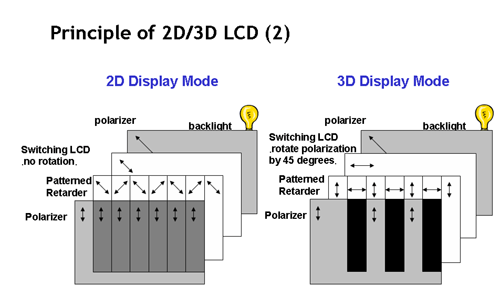COMDEX 2003 Display Coverage: Prelude to a CES
by Kristopher Kubicki on November 26, 2003 10:50 PM EST- Posted in
- Trade Shows
Sharp's 3D LCD
Fortunately, Sharp has a few images that can describe the technology better than we can. In a nutshell, instead of allowing the image to pass through the TFT substrate, a pattern retarder blocks alternating segments of light through the LCD. If you are sitting correctly, you will see one slightly angled image in your left eye, and a slightly different angled image in your right eye. The human brain perceives these two offset images as depth.Click to enlarge.
This is not a new concept. Using the red and blue glasses in 3D movie theaters accomplishes the same effect by filtering the red offset image via one eye and the blue offset image in the other eye. Of course, the revolutionary thing here is that we do not need goggles to achieve the same effect.
Click to enlarge.
Granted, this technology is not perfect yet. You do have to sit fairly still for the effect to work. Moving your head from left to right will result in a sort of wavy effect as you go from 3D to 2D and back to 3D. Also, since the retarding layer blocks alternate projections of the image, you actually are viewing only half of the screens capable brightness. On the other hand, this technology has a lot of promise. It is very easy to go from 2D to 3D and back, since the retarding layer can also be an LCD (power just needs to be applied over the LCD to turn it on and off). This also makes it relatively cost-effective. Furthermore, the technology is extremely capable. Even playing 2D developed games allow for an interesting degree of immersion; particularly, racing games tend to produce that 3D tunnel effect. We had the opportunity to demo a few games in the Sharp suite, and the small go-kart demo (which is natively a 2D game), produced an extremely captivating experience.
Video games will obviously be an enormous market for this emerging technology. Consider the fact that most games as we know it already exist in 3D. It is not very hard for a software driver to take two slightly different samples of UT2003 instead of one during game play, and then project both images one on top of each other to the signal output. Sharp is already working with NVIDIA and Microsoft for just that. Do not be surprised if we hear more about this technology at CES.
Sharp's next step for a technology like this would be to incorporate retina tracking capabilities in the monitor that could adjust the retarding layer to each person's eyes. As a bonus, this would allow you to move and view the 3D effect as well! Sanyo and Sony are also working on similar technology, but kudos to Sharp for being the first to bring a real world example to the world!












16 Comments
View All Comments
TwYsTeD - Sunday, November 30, 2003 - link
Sounds good :)KristopherKubicki - Saturday, November 29, 2003 - link
Hi Twysted,Working on a DVDR roundup first, then ill move over to the two LCD battle. Im waiting for a new dualhead video card from sapphire which should be here monday.
Kristopher
TwYsTeD - Saturday, November 29, 2003 - link
Great info :)When will we see the article for the 213T vs 2001FP? ;)
KristopherKubicki - Saturday, November 29, 2003 - link
Actually, LGPhilips LCD invented IPS :) Hitachi and NEC are both using LGP's panels and technology.Hitachi has been on a pretty decent spiral into the ground for the last few years :( particularly as far as R+D
Kristopher
miomao - Saturday, November 29, 2003 - link
Great info about LCD! :)For 19'' S-IPS panel I wait for Hitachi or Nec.
The Eizo L565 have Hitachi panel and is the best I ever seen.
...can be because Hitachi have invented IPS technology? ;)
artifex - Friday, November 28, 2003 - link
Two AGP cards in a single box? How did Liebermann manage that?